Water
Water
Ալֆրեդ Սիսլեյ
Ալֆրեդ Սիսլեյ
Why do you think water resource management is important in permaculture?
Why do you think water resource management is important in permaculture?
For years, the Indian village of Gaurav Adi had a shortage of water. They got a lot of rain for a few months, but it quickly flowed down the hills, causing erosion, and when the very hot and dry months came, all the water evaporated from the surface of the ground. Enough water didn't reach the groundwater reserves, so the water table was too low in the summer, and the springs, lakes, ponds, and rivers dried up during dry periods; all of these were only fed by groundwater.
In the dry months, they had to bring water trucks to have enough drinking water, and there wasn't enough water for growing food.
The villagers decided to participate in the Water Cup Competition organized by the Paani Foundation (www.paanifoundation.in). Together they hand-dug swales in the 5 hilly areas of their village.
In the dry months, they had to bring water trucks to have enough drinking water, and there wasn't enough water for growing food.
The villagers decided to participate in the Water Cup Competition organized by the Paani Foundation (www.paanifoundation.in). Together they hand-dug swales in the 5 hilly areas of their village.
Swales are channels dug on contour perpendicular to the slope to slow the flow of water down these areas, preventing erosion and promoting percolation of rainwater to replenish groundwater reserves where it is stored and protected from evaporation. Planting trees and other plants along the swale can provide shade and mulch, which also decrease evaporation. As a result, now the water flowing down during heavy rains in the wet period is slowed and soaked to replenish the groundwater. Throughout the year, this groundwater slowly feeds springs and ponds in lower areas where people live so that the spring water can be used for drinking and the pond water for irrigation of food crops. Restoring the groundwater also fixed a lot of social problems, as when the villagers have a stable water supply, they have a stable income and don't need to leave the village to find low-wage work in the city during the dry season.
1
2
For years, the Indian village of Gaurav Adi had a shortage of water. They got a lot of rain for a few months, but it quickly flowed down the hills, causing erosion, and when the very hot and dry months came, all the water evaporated from the surface of the ground. Enough water didn't reach the groundwater reserves, so the water table was too low in the summer, and the springs, lakes, ponds, and rivers dried up during dry periods; all of these were only fed by groundwater.
In the dry months, they had to bring water trucks to have enough drinking water, and there wasn't enough water for growing food.
The villagers decided to participate in the Water Cup Competition organized by the Paani Foundation (www.paanifoundation.in). Together they hand-dug swales in the 5 hilly areas of their village.
In the dry months, they had to bring water trucks to have enough drinking water, and there wasn't enough water for growing food.
The villagers decided to participate in the Water Cup Competition organized by the Paani Foundation (www.paanifoundation.in). Together they hand-dug swales in the 5 hilly areas of their village.
Swales are channels dug on contour perpendicular to the slope to slow the flow of water down these areas, preventing erosion and promoting percolation of rainwater to replenish groundwater reserves where it is stored and protected from evaporation. Planting trees and other plants along the swale can provide shade and mulch, which also decrease evaporation. As a result, now the water flowing down during heavy rains in the wet period is slowed and soaked to replenish the groundwater. Throughout the year, this groundwater slowly feeds springs and ponds in lower areas where people live so that the spring water can be used for drinking and the pond water for irrigation of food crops. Restoring the groundwater also fixed a lot of social problems, as when the villagers have a stable water supply, they have a stable income and don't need to leave the village to find low-wage work in the city during the dry season.
1
2
Groundwater level in the village
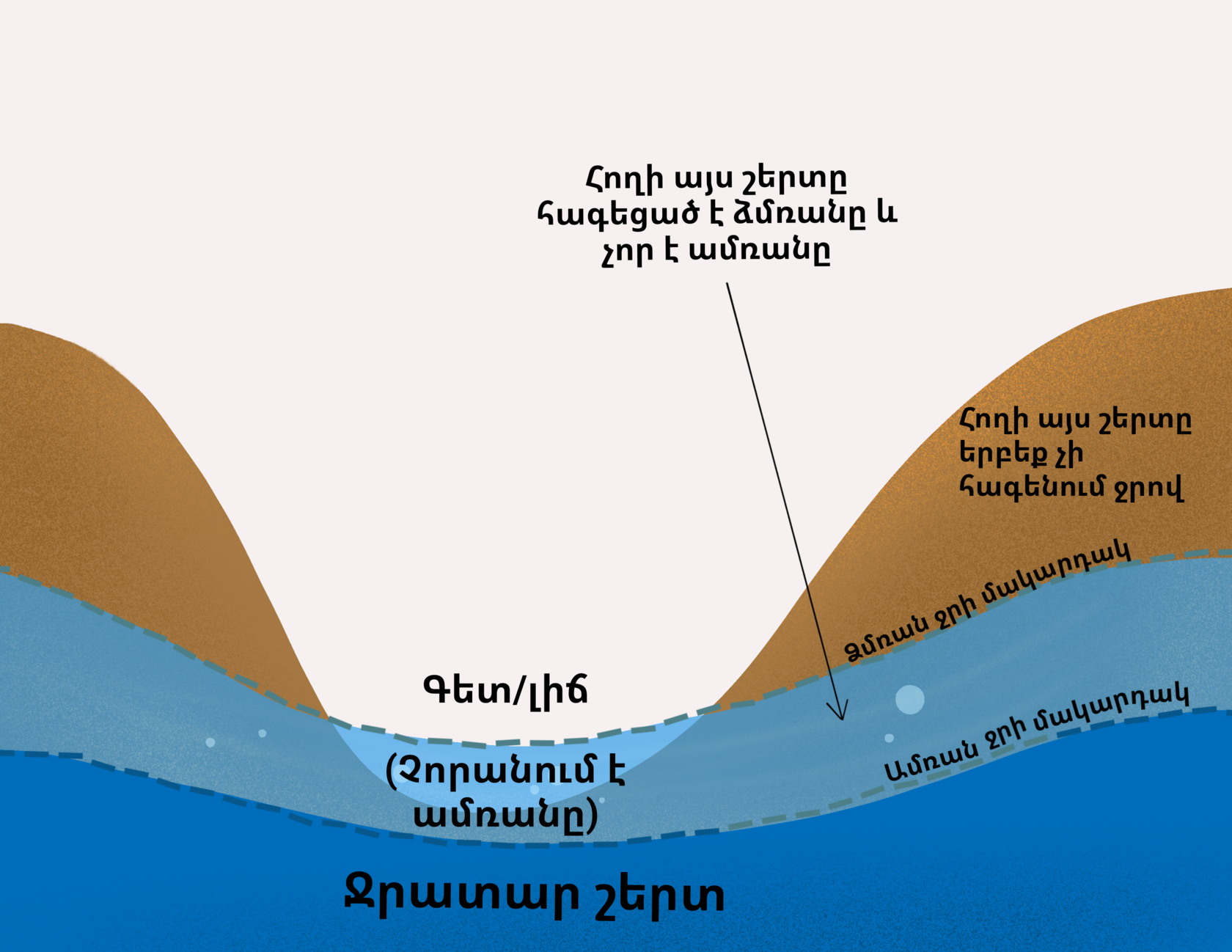
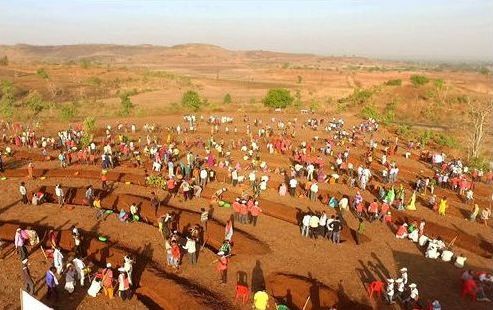

Swales
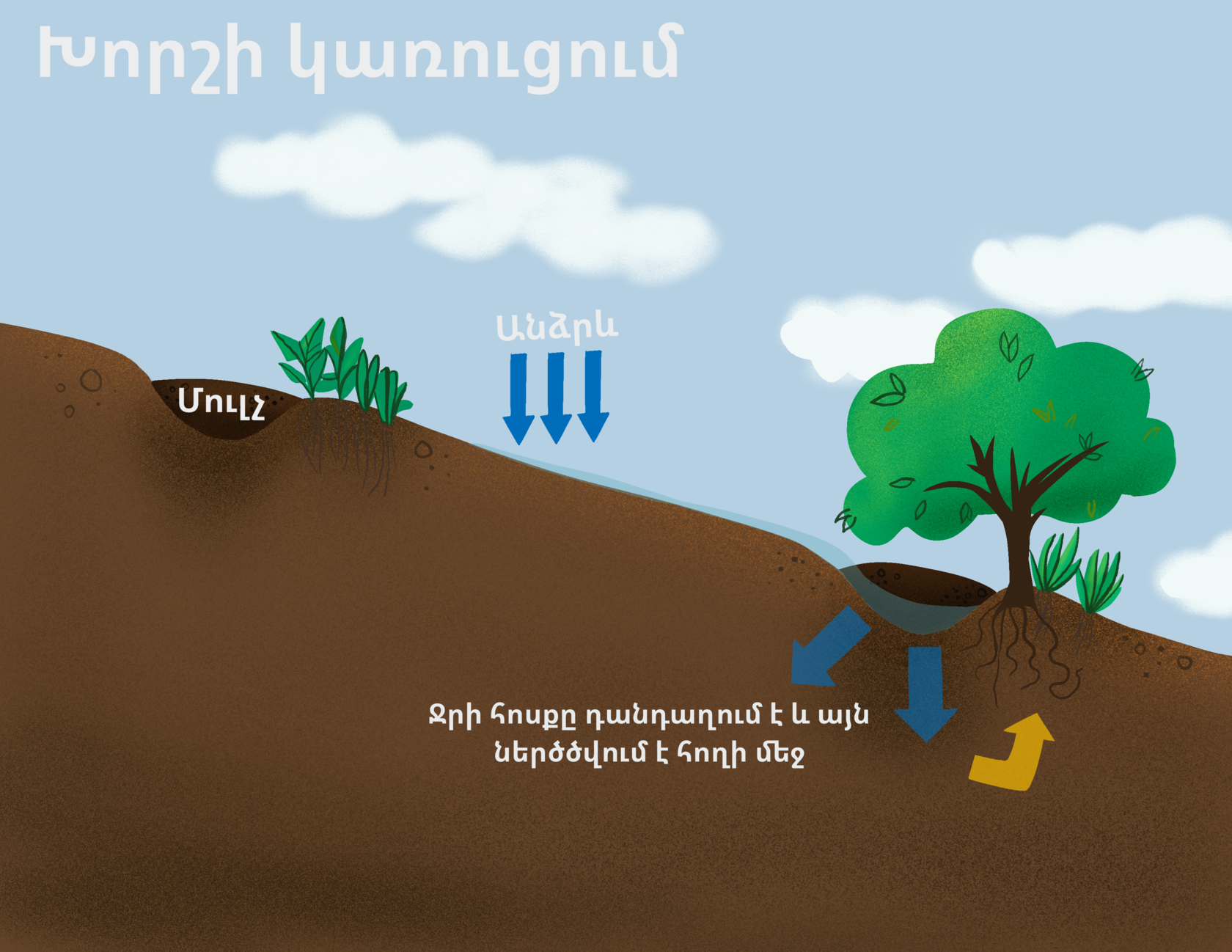
Groundwater level in the village



Swales

It is important to replenish groundwater. However, it almost never rains in Egypt, so there is no way of replenishing groundwater. The only water available for drinking and irrigation is thousands of years old groundwater. In this case, the goal is to make these reserves last for as long as possible.
Permaculture approaches, such as carefully placed windbreaks, the use of diverse local, drought-resistant species, and heavy mulching can help the groundwater last for hundreds of years longer, allowing people to continue living there.
Permaculture approaches, such as carefully placed windbreaks, the use of diverse local, drought-resistant species, and heavy mulching can help the groundwater last for hundreds of years longer, allowing people to continue living there.
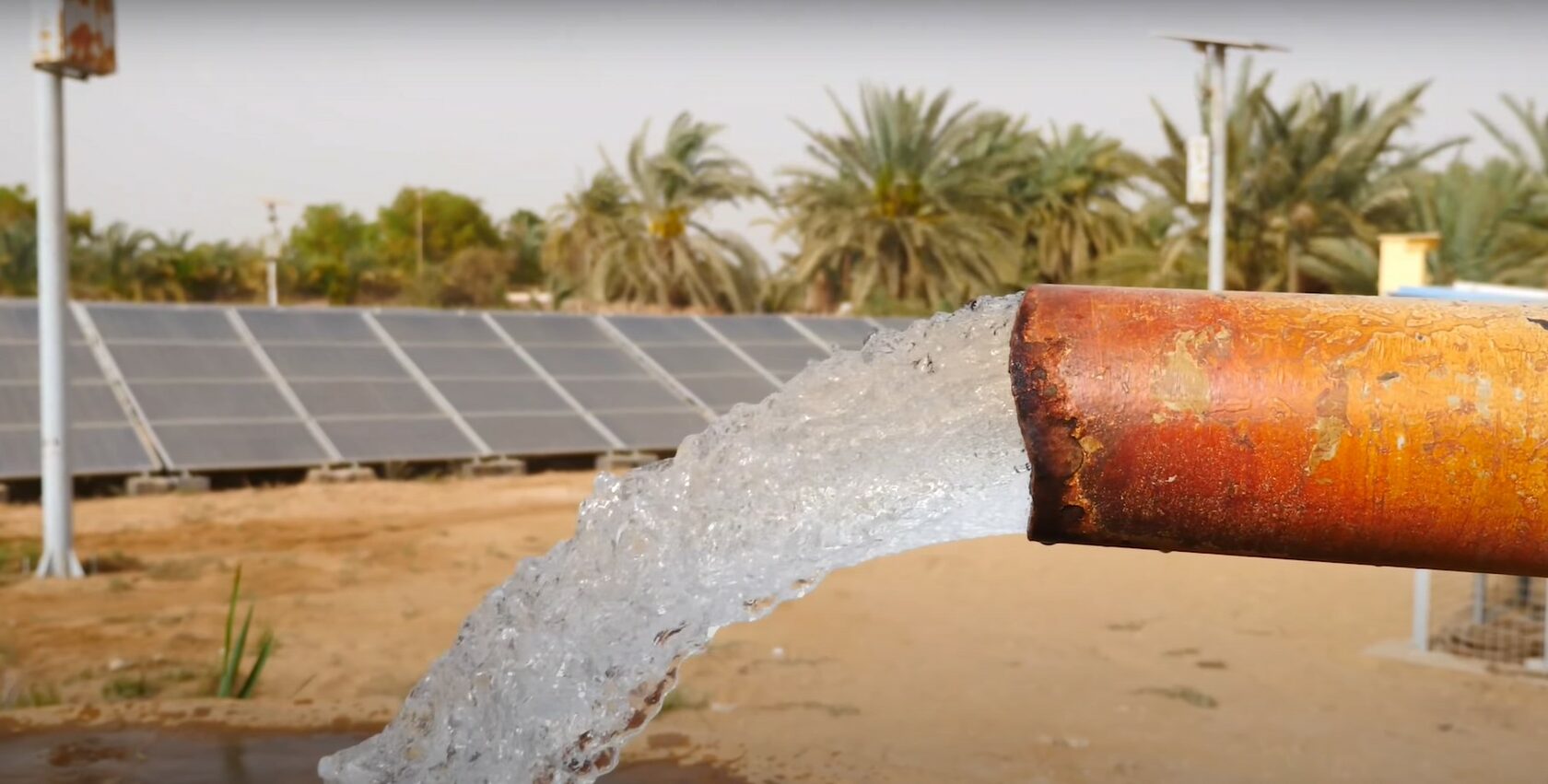
It is important to replenish groundwater. However, it almost never rains in Egypt, so there is no way of replenishing groundwater. The only water available for drinking and irrigation is thousands of years old groundwater. In this case, the goal is to make these reserves last for as long as possible.
Permaculture approaches, such as carefully placed windbreaks, the use of diverse local, drought-resistant species, and heavy mulching can help the groundwater last for hundreds of years longer, allowing people to continue living there.
Permaculture approaches, such as carefully placed windbreaks, the use of diverse local, drought-resistant species, and heavy mulching can help the groundwater last for hundreds of years longer, allowing people to continue living there.

Surely soil. When soil is rich in organic matter, it absorbs and retains large amounts of water like a sponge. Covering the soil with a thick layer of mulch will not only reduce water evaporation from the soil, but will also add additional organic matter to the soil as the mulch breaks down over time. As a result, the soil will be able to store more water over time.
The following video shows how the ability of soil to absorb water changes depending on the presence of organic matter in the soil.
In your opinion, which of the mentioned is the most important reservoir for rainwater collection?
Surely soil. When soil is rich in organic matter, it absorbs and retains large amounts of water like a sponge. Covering the soil with a thick layer of mulch will not only reduce water evaporation from the soil, but will also add additional organic matter to the soil as the mulch breaks down over time. As a result, the soil will be able to store more water over time. The video below shows how soil capacity changes depending on the quality of the soil and the presence of organic matter.
The root systems of wetland plants, such as reeds, have a huge network of microorganisms like bacteria and fungi that can biodegrade most minor pollutants, breaking them down into harmless elements. The wetland plants themselves can absorb heavy metals from the water through their roots.
Geoff Lawton has implemented this system in his desert permaculture system, and here is what his reed beds look like. Water coming from the house and cafe go through pipes to beds made of cob (a natural alternative to cement made of clay and straw) containing 65 cm of gravel, which reed roots grow into. As water passes through the gravel, it is cleaned by the roots and microorganisms and comes out through pipes leading to fruit trees and other crops.
Geoff Lawton has implemented this system in his desert permaculture system, and here is what his reed beds look like. Water coming from the house and cafe go through pipes to beds made of cob (a natural alternative to cement made of clay and straw) containing 65 cm of gravel, which reed roots grow into. As water passes through the gravel, it is cleaned by the roots and microorganisms and comes out through pipes leading to fruit trees and other crops.
1
2
For many of us, having access to clean water is often taken for granted, however, in parts of the world that have run out of a clean water supply, people are dying and ecosystems are being ruined due to poor sanitation. Therefore we should be mindful not to waste this precious resource and make full use of every drop. You have probably heard of recycling plastics, paper and other materials to extend their life before being thrown away. Did you know that water can also be recycled, so that the same water is used several times for different purposes?
Graywater is leftover, untreated water generated from washing machines, showers, and sinks. In permaculture, is diverted to reed beds, which clean it and allow it to be used again for irrigation of plants. Plants and biologically active soil can clean dirty water.
Graywater is leftover, untreated water generated from washing machines, showers, and sinks. In permaculture, is diverted to reed beds, which clean it and allow it to be used again for irrigation of plants. Plants and biologically active soil can clean dirty water.
For many of us, having access to clean water is often taken for granted, however, in parts of the world that have run out of a clean water supply, people are dying and ecosystems are being ruined due to poor sanitation. Therefore we should be mindful not to waste this precious resource and make full use of every drop. You have probably heard of recycling plastics, paper and other materials to extend their life before being thrown away. Did you know that water can also be recycled, so that the same water is used several times for different purposes?
Graywater is leftover, untreated water generated from washing machines, showers, and sinks. In permaculture, is diverted to reed beds, which clean it and allow it to be used again for irrigation of plants. Plants and biologically active soil can clean dirty water.
Graywater is leftover, untreated water generated from washing machines, showers, and sinks. In permaculture, is diverted to reed beds, which clean it and allow it to be used again for irrigation of plants. Plants and biologically active soil can clean dirty water.
The root systems of wetland plants, such as reeds, have a huge network of microorganisms like bacteria and fungi that can biodegrade most minor pollutants, breaking them down into harmless elements. The wetland plants themselves can absorb heavy metals from the water through their roots.
Geoff Lawton has implemented this system in his desert permaculture system, and here is what his reed beds look like. Water coming from the house and cafe go through pipes to beds made of cob (a natural alternative to cement made of clay and straw) containing 65 cm of gravel, which reed roots grow into. As water passes through the gravel, it is cleaned by the roots and microorganisms and comes out through pipes leading to fruit trees and other crops.
Geoff Lawton has implemented this system in his desert permaculture system, and here is what his reed beds look like. Water coming from the house and cafe go through pipes to beds made of cob (a natural alternative to cement made of clay and straw) containing 65 cm of gravel, which reed roots grow into. As water passes through the gravel, it is cleaned by the roots and microorganisms and comes out through pipes leading to fruit trees and other crops.
1
2
Jeff Lawton's Wastewater Recycling System
Jeff Lawton's Wastewater Recycling System
Properly designed roads have a slight slope to either side, allowing rainwater to drain easily. However, where this water runoff ends up is what makes the difference between sustainable and non-sustainable rainwater management.
Conventionally, during rain storms and other precipitation events, street surfaces built from materials such as asphalt and concrete, along with rooftops, carry stormwater to storm drains instead of allowing the water to percolate through the soil. This causes a lowering of the water table (because groundwater recharge is lessened) and flooding since the amount of water that remains on the surface is greater. Most municipal storm sewer systems discharge untreated stormwater to streams, rivers, and bays.
Conventionally, during rain storms and other precipitation events, street surfaces built from materials such as asphalt and concrete, along with rooftops, carry stormwater to storm drains instead of allowing the water to percolate through the soil. This causes a lowering of the water table (because groundwater recharge is lessened) and flooding since the amount of water that remains on the surface is greater. Most municipal storm sewer systems discharge untreated stormwater to streams, rivers, and bays.
The permaculture solution is to divert this water to water the local landscape and allow it to recharge local groundwater reserves.
Brad Lancaster from Arizona shows how he has diverted the rainwater draining from the street to water his front garden and recharge the groundwater. Meanwhile, his neighbor's property could receive more water runoff than his, but all of it drains into storm drains, so his property is very dry. Seeing how Brad and other permaculturists/Guerilla gardeners were using street water runoff to grow along streets has led to more sustainable street runoff harvesting systems implemented by the municipality. In Arizona, all the street runoff used to go to gutters, but now the municipalities are putting in sustainable street runoff harvesting systems like this one which diverts runoff to grow local vegetation, making the desert environment greener and cooler.
Brad Lancaster from Arizona shows how he has diverted the rainwater draining from the street to water his front garden and recharge the groundwater. Meanwhile, his neighbor's property could receive more water runoff than his, but all of it drains into storm drains, so his property is very dry. Seeing how Brad and other permaculturists/Guerilla gardeners were using street water runoff to grow along streets has led to more sustainable street runoff harvesting systems implemented by the municipality. In Arizona, all the street runoff used to go to gutters, but now the municipalities are putting in sustainable street runoff harvesting systems like this one which diverts runoff to grow local vegetation, making the desert environment greener and cooler.
1
2
3
If we have greener streets, then during summer, they can cool down entire cities by up to 12°C. This is because artificial surfaces such as concrete and asphalt reflect solar radiation, while plants absorb it. They also slowly release the water they absorb from their leaves, resulting in evaporative cooling.
Even in very densely populated urban streets with little room for vegetation, runoff from streets can be diverted to swales built alongside the street, which will ideally be mulched and planted to increase the ease of water absorption. Here are some examples of urban swales for street water runoff absorption.
Even in very densely populated urban streets with little room for vegetation, runoff from streets can be diverted to swales built alongside the street, which will ideally be mulched and planted to increase the ease of water absorption. Here are some examples of urban swales for street water runoff absorption.
Properly designed roads have a slight slope to either side, allowing rainwater to drain easily. However, where this water runoff ends up is what makes the difference between sustainable and non-sustainable rainwater management.
Conventionally, during rain storms and other precipitation events, street surfaces built from materials such as asphalt and concrete, along with rooftops, carry stormwater to storm drains instead of allowing the water to percolate through the soil. This causes a lowering of the water table (because groundwater recharge is lessened) and flooding since the amount of water that remains on the surface is greater. Most municipal storm sewer systems discharge untreated stormwater to streams, rivers, and bays.
Conventionally, during rain storms and other precipitation events, street surfaces built from materials such as asphalt and concrete, along with rooftops, carry stormwater to storm drains instead of allowing the water to percolate through the soil. This causes a lowering of the water table (because groundwater recharge is lessened) and flooding since the amount of water that remains on the surface is greater. Most municipal storm sewer systems discharge untreated stormwater to streams, rivers, and bays.
The permaculture solution is to divert this water to water the local landscape and allow it to recharge local groundwater reserves.
Brad Lancaster from Arizona shows how he has diverted the rainwater draining from the street to water his front garden and recharge the groundwater. Meanwhile, his neighbor's property could receive more water runoff than his, but all of it drains into storm drains, so his property is very dry. Seeing how Brad and other permaculturists/Guerilla gardeners were using street water runoff to grow along streets has led to more sustainable street runoff harvesting systems implemented by the municipality. In Arizona, all the street runoff used to go to gutters, but now the municipalities are putting in sustainable street runoff harvesting systems like this one which diverts runoff to grow local vegetation, making the desert environment greener and cooler.
Brad Lancaster from Arizona shows how he has diverted the rainwater draining from the street to water his front garden and recharge the groundwater. Meanwhile, his neighbor's property could receive more water runoff than his, but all of it drains into storm drains, so his property is very dry. Seeing how Brad and other permaculturists/Guerilla gardeners were using street water runoff to grow along streets has led to more sustainable street runoff harvesting systems implemented by the municipality. In Arizona, all the street runoff used to go to gutters, but now the municipalities are putting in sustainable street runoff harvesting systems like this one which diverts runoff to grow local vegetation, making the desert environment greener and cooler.
1
2
3
If we have greener streets, then during summer, they can cool down entire cities by up to 12°C. This is because artificial surfaces such as concrete and asphalt reflect solar radiation, while plants absorb it. They also slowly release the water they absorb from their leaves, resulting in evaporative cooling.
Even in very densely populated urban streets with little room for vegetation, runoff from streets can be diverted to swales built alongside the street, which will ideally be mulched and planted to increase the ease of water absorption. Here are some examples of urban swales for street water runoff absorption.
Even in very densely populated urban streets with little room for vegetation, runoff from streets can be diverted to swales built alongside the street, which will ideally be mulched and planted to increase the ease of water absorption. Here are some examples of urban swales for street water runoff absorption.
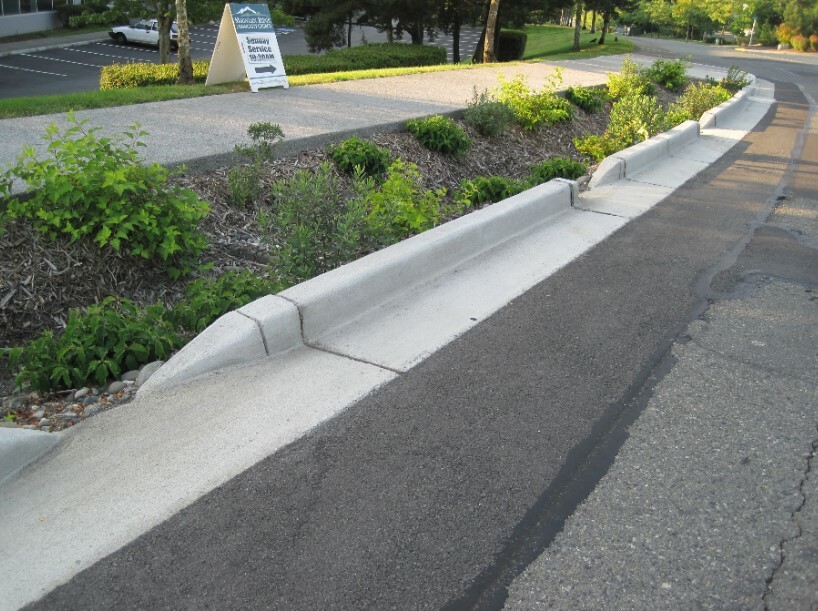


There are also interesting examples of accidental swales being built along roads or other man-made structures, such as this canal that was built on a berm on a contour passing through the Arizona desert. As a result, a forest has grown by itself on one side of the canal without any human intervention. This is because rainwater water flowing down the nearby slope is slowed by the canal's berm and allowed to infiltrate into the ground, replenishing groundwater and raising the water table. This forest would otherwise be impossible, considering it is in the middle of the desert with very little water.





There are also interesting examples of accidental swales being built along roads or other man-made structures, such as this canal that was built on a berm on a contour passing through the Arizona desert. As a result, a forest has grown by itself on one side of the canal without any human intervention. This is because rainwater water flowing down the nearby slope is slowed by the canal's berm and allowed to infiltrate into the ground, replenishing groundwater and raising the water table. This forest would otherwise be impossible, considering it is in the middle of the desert with very little water.


The easiest way of harvesting rainwater for storage in tanks is from roofs. Most roofs already have gutters and all that is needed is to collect the water. This water can then be used in the dryer months to water annual vegetables which have shallower root systems that usually cannot reach groundwater, so require irrigation during dry months.
You can use this calculator to see how many liters of water fall on the roof of your house/apartment building in a year. https://www.ruvival.de/rainwater-collection-calculator/
For example, the average annual precipitation in Armenia is 560 mm and the average roof size is 60 sqm, so if all the water is harvested it can add up to 34,000 liters per year. 600 liters of water is the maximum amount needed to irrigate 1 sqm of vegetables from May till September, when rainfall may not be enough, so with 34,000 liters it is possible to water a 55 sqm vegetable garden
You can use this calculator to see how many liters of water fall on the roof of your house/apartment building in a year. https://www.ruvival.de/rainwater-collection-calculator/
For example, the average annual precipitation in Armenia is 560 mm and the average roof size is 60 sqm, so if all the water is harvested it can add up to 34,000 liters per year. 600 liters of water is the maximum amount needed to irrigate 1 sqm of vegetables from May till September, when rainfall may not be enough, so with 34,000 liters it is possible to water a 55 sqm vegetable garden


The easiest way of harvesting rainwater for storage in tanks is from roofs. Most roofs already have gutters and all that is needed is to collect the water. This water can then be used in the dryer months to water annual vegetables which have shallower root systems that usually cannot reach groundwater, so require irrigation during dry months.
You can use this calculator to see how many liters of water fall on the roof of your house/apartment building in a year. https://www.ruvival.de/rainwater-collection-calculator/
For example, the average annual precipitation in Armenia is 560 mm and the average roof size is 60 sqm, so if all the water is harvested it can add up to 34,000 liters per year. 600 liters of water is the maximum amount needed to irrigate 1 sqm of vegetables from May till September, when rainfall may not be enough, so with 34,000 liters it is possible to water a 55 sqm vegetable garden
You can use this calculator to see how many liters of water fall on the roof of your house/apartment building in a year. https://www.ruvival.de/rainwater-collection-calculator/
For example, the average annual precipitation in Armenia is 560 mm and the average roof size is 60 sqm, so if all the water is harvested it can add up to 34,000 liters per year. 600 liters of water is the maximum amount needed to irrigate 1 sqm of vegetables from May till September, when rainfall may not be enough, so with 34,000 liters it is possible to water a 55 sqm vegetable garden
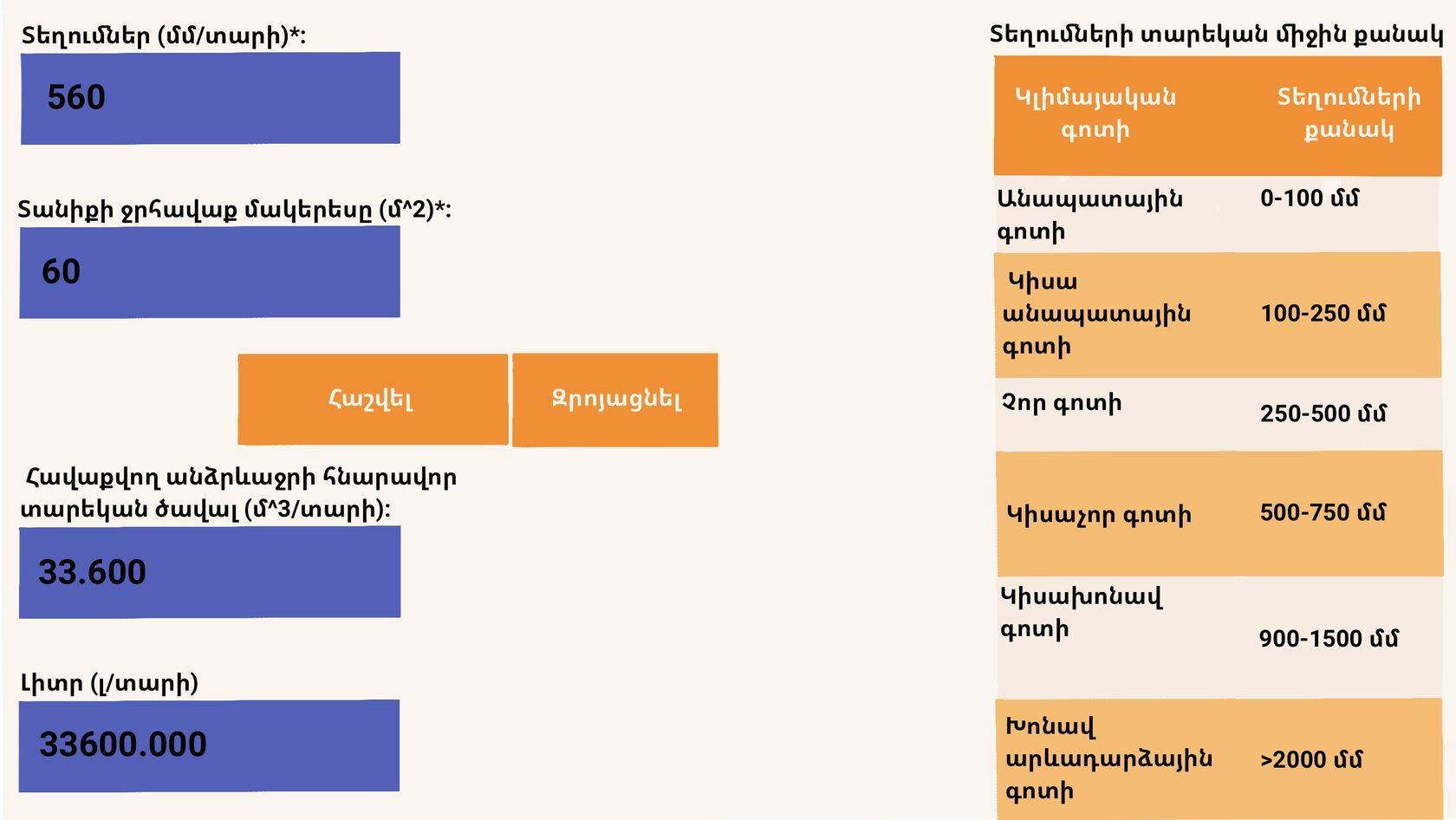
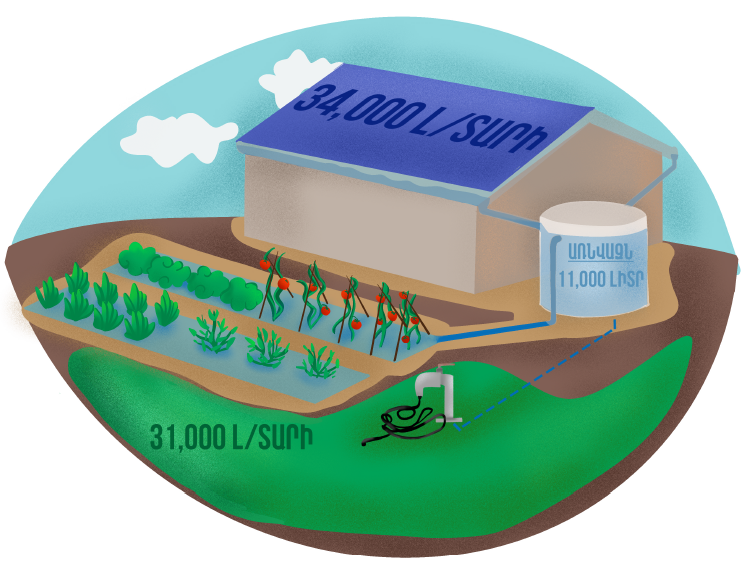
Imagine that you collect rainwater from the roof in tanks. What do you think is the best place to put tanks?
Imagine that you collect rainwater from the roof in tanks. What do you think is the best place to put tanks?
The best place is at the highest part of the property, or at least higher than the level of the vegetable garden, so that gravity can be used instead of a pump, making the system energy efficient and therefore, more sustainable.
The same concept is used in large permaculture farms, such as Yeoman's Yobarnie Farm, where every drop of rainwater is collected in ponds at points higher than the regions that will require irrigation from the ponds in dryer months.
The same concept is used in large permaculture farms, such as Yeoman's Yobarnie Farm, where every drop of rainwater is collected in ponds at points higher than the regions that will require irrigation from the ponds in dryer months.
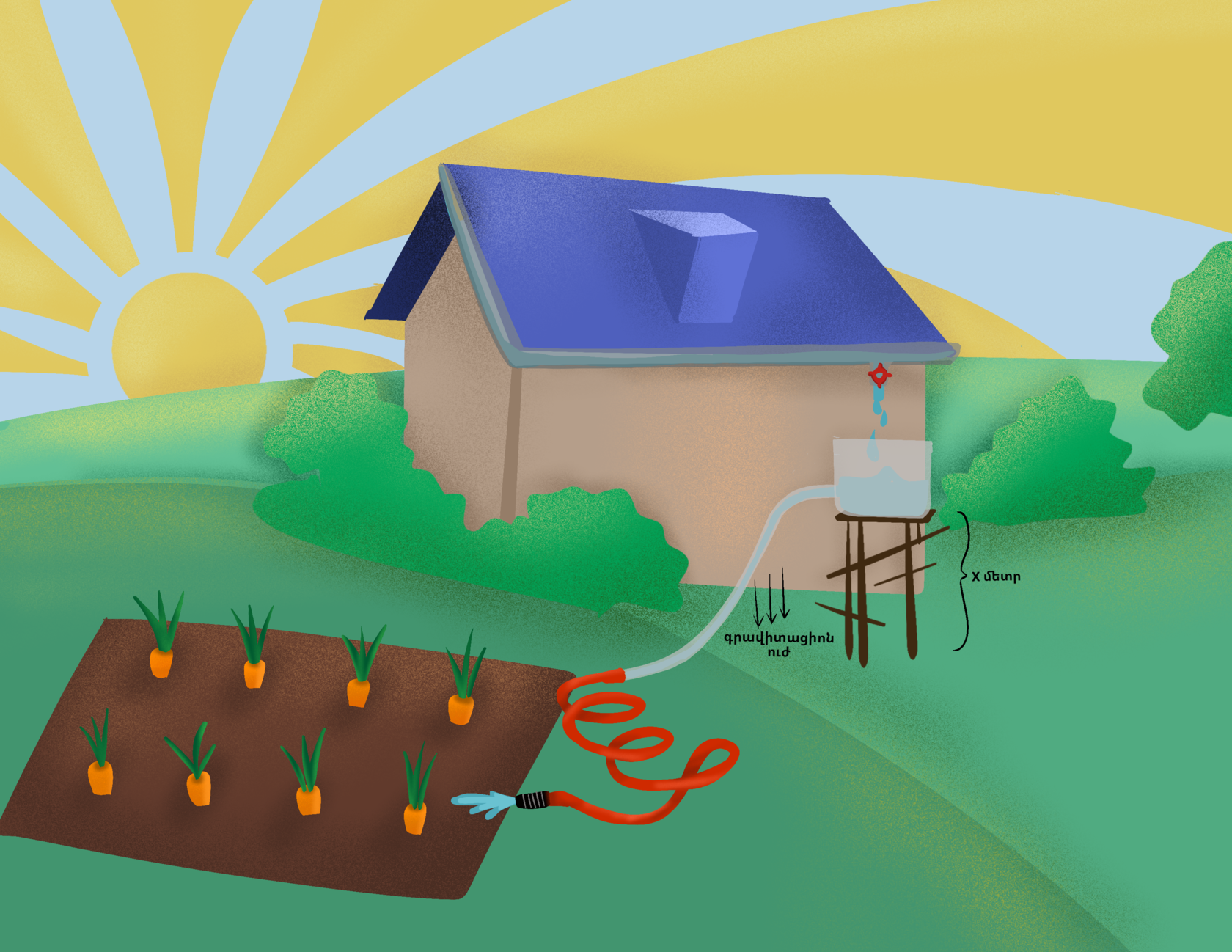
The best place is at the highest part of the property, or at least higher than the level of the vegetable garden, so that gravity can be used instead of a pump, making the system energy efficient and therefore, more sustainable.
The same concept is used in large permaculture farms, such as Yeoman's Yobarnie Farm, where every drop of rainwater is collected in ponds at points higher than the regions that will require irrigation from the ponds in dryer months.
The same concept is used in large permaculture farms, such as Yeoman's Yobarnie Farm, where every drop of rainwater is collected in ponds at points higher than the regions that will require irrigation from the ponds in dryer months.
Ուզում եմ կարդալ ավելին

It is important to understand that every permaculturist begins by designing his/her permaculture dream area before properly organizing water resources. The first step in designing a permaculture system is to gather information about the existing elements and patterns in the area around which the new design will be created. Only after a good understanding of the existing environment is it possible to make the right decisions about how and where to add new elements.
First, you need to create a base map. This map should contain the following information:
First, you need to create a base map. This map should contain the following information:
- the site boundaries and dimensions
- the access points and routes through the site
- significant bodies of water
- the direction of the north
- Important objects (building, greenhouse, statue, warehouse, etc.), the distance between them (you can measure with a phone app or a meter), and the gradient (use a compass)
- Available working tools
- Events characteristic of the area: natural disasters or gatherings
1
2
It is important to understand that every permaculturist begins by designing his/her permaculture dream area before properly organizing water resources. The first step in designing a permaculture system is to gather information about the existing elements and patterns in the area around which the new design will be created. Only after a good understanding of the existing environment is it possible to make the right decisions about how and where to add new elements.
First, you need to create a base map. This map should contain the following information:
First, you need to create a base map. This map should contain the following information:
- the site boundaries and dimensions
- the access points and routes through the site
- significant bodies of water
- the direction of the north
- Important objects (building, greenhouse, statue, warehouse, etc.), the distance between them (you can measure with a phone app or a meter), and the gradient (use a compass)
- Available working tools
- Events characteristic of the area: natural disasters or gatherings
1
2
Base map example

Base map example

3
When the base map is ready, you should work on marking the slopes.
If the site is small and the slope insignificant, it may be unnecessary to consider this part.
The easiest way of identifying slopes is through the Google Maps Relief function, which shows the differences in elevations of different parts of the map and highlights ridges and valleys. Water will always flow from higher to lower elevations and from ridges to valleys. If there are neighboring slopes channeling water and materials towards or away from the site, these need to be recorded.
If the site is small and the slope insignificant, it may be unnecessary to consider this part.
The easiest way of identifying slopes is through the Google Maps Relief function, which shows the differences in elevations of different parts of the map and highlights ridges and valleys. Water will always flow from higher to lower elevations and from ridges to valleys. If there are neighboring slopes channeling water and materials towards or away from the site, these need to be recorded.

3
When the base map is ready, you should work on marking the slopes.
If the site is small and the slope insignificant, it may be unnecessary to consider this part.
The easiest way of identifying slopes is through the Google Maps Relief function, which shows the differences in elevations of different parts of the map and highlights ridges and valleys. Water will always flow from higher to lower elevations and from ridges to valleys. If there are neighboring slopes channeling water and materials towards or away from the site, these need to be recorded.
If the site is small and the slope insignificant, it may be unnecessary to consider this part.
The easiest way of identifying slopes is through the Google Maps Relief function, which shows the differences in elevations of different parts of the map and highlights ridges and valleys. Water will always flow from higher to lower elevations and from ridges to valleys. If there are neighboring slopes channeling water and materials towards or away from the site, these need to be recorded.

What did you learn about the role sustainable water resource management plays in permaculture systems?
What did you learn about the role sustainable water resource management plays in permaculture systems?
Discussion 1: preparatory tasks
Do the task before discussion 1 and come ready for the discussion.
1. Talk to your school staff and find out if:
a. Where does the water used in the school come from?
b. Where does the used water go?
c. How is rainwater managed?
Think about what could be improved in the water management system and share your experience during discussion 1.
2. On your school permaculture map, add the necessary elements for the base permaculture map and use the arrows to show the correct directions of the slopes. Send your work to the coach in chat.
By the way, it is possible that the Google maps map does not include the smallest slopes in your area. To make sure that you have recorded all available slopes, visit the area yourself and carefully inspect the existing slopes.
1. Talk to your school staff and find out if:
a. Where does the water used in the school come from?
b. Where does the used water go?
c. How is rainwater managed?
Think about what could be improved in the water management system and share your experience during discussion 1.
2. On your school permaculture map, add the necessary elements for the base permaculture map and use the arrows to show the correct directions of the slopes. Send your work to the coach in chat.
By the way, it is possible that the Google maps map does not include the smallest slopes in your area. To make sure that you have recorded all available slopes, visit the area yourself and carefully inspect the existing slopes.
